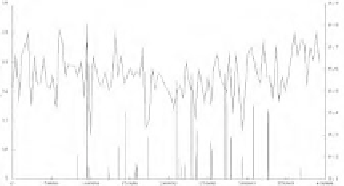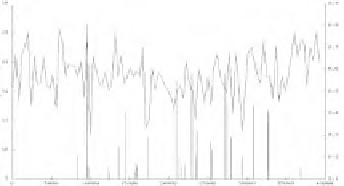Information Technology Reference
In-Depth Information
Chromosome 21 (7467bp)
Chromosome 21 (7467bp)
= 1 kb
= 1 kb
L3640
L3640
L7171
L7171
1.1.1.1.1.1.1.1.1
W
17 18
17 18
19
19
20
20
21
21
22 23
22 23
24
24
25
25
26 27
26 27
28
28
29 30
29 30
31
31
C
C
1
1
2
2
3
3
4
4
5
5
6 7
6 7
8
8
9
9
10
10
11
11
12
12
1314 1516
1314 1516
Figure 11
. Region of 74 kb around the switching point of chromosome 21 of
L. major
.
L7171 and L3640 are two cosmids containing the overlapping fragments of
chromosome 21. The two strands and the encoded genes are represented in different
colors. The curvature analysis of the 40 kb around the switch region is shown in the
lower window.
chromosome 21, the first 16 ORFs are encoded on the Crick strand, while the rest of them
are localised on the Watson strand (Figure 12). Between the two coding regions there are
1,602 nt, which are part of the so-called switching region, that do not contain neither
predicted CDS nor DNA with potential to form hairpin structures. Moreover, this region
shows a high DNA curvature with a maximum value of GC skew, as detected by the Bend-
it program [46, 47].
The physical features described for the switching point of chromosome 21
characterise also the switching points of other chromosomes of the parasite (chr. 1, 3, 4,
19), suggesting that these regions can be involved in promotion of DNA transcription or
can indicate the presence of an origin of replication. In support of the first hypothesis, very
recently it was shown, by transfectional studies, that the switching point region seems to
drive the expression of the entire chr1 in Leishmania major Friedlin [48].
DNA isolated from normal eukaryotic cells by standard methods exhibit particular
fragility resulting in ~50 kb fragments. Breakage at hypersensitive/fragile sites is thought to
be due to nucleolytic cleavage and/or localized, non-random release of torsional stress [49-
52]. The sequence of several breakpoints of human DNA was recently determined and by
multiple alignment, sequence similarities were found among the various breakpoints, both
in short and longer stretches of the DNA [53]. An analysis with the plot.it server showed
peculiar conformational characteristics (sharp transition or with a centre of symmetry)
located exactly at the experimentally determined breakpoints (Figure 13A) [53]. These,































